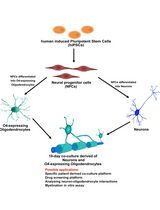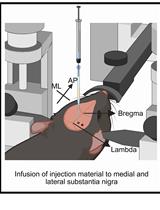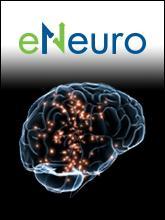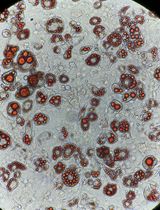- EN - English
- CN - 中文
Integration of Human Induced Pluripotent Stem Cell (hiPSC)-Derived Neurons into Rat Brain
人诱导多能干细胞(hiPSC)源神经元与大鼠脑回路的整合
发布: 2020年09月05日第10卷第17期 DOI: 10.21769/BioProtoc.3746 浏览次数: 6157
评审: Patrick Ovando-RocheAnthony FlamierThirupugal GovindarajanAnonymous reviewer(s)

相关实验方案

人 iPSC 衍生神经元与少突胶质细胞共培养用于髓鞘形成的小分子筛选分析
Stefanie Elke Chie [...] Maria Consolata Miletta
2025年05月05日 3265 阅读

基于 rAAV-α-Syn 与 α-Syn 预成纤维共同构建的帕金森病一体化小鼠模型
Santhosh Kumar Subramanya [...] Poonam Thakur
2025年12月05日 1406 阅读
Abstract
Human neuron transplantation offers novel opportunities for modeling human neurologic diseases and potentially replacement therapies. However, the complex structure of the human cerebral cortex, which is organized in six layers with tightly interconnected excitatory and inhibitory neuronal networks, presents significant challenges for in vivo transplantation techniques to obtain a balanced, functional and homeostatically stable neuronal network. Here, we present a protocol to introduce human induced pluripotent stem cell (hiPSC)-derived neural progenitors to rat brains. Using this approach, hiPSC-derived neurons structurally integrate into the rat forebrain, exhibit electrophysiological characteristics, including firing, excitatory and inhibitory synaptic activity, and establish neuronal connectivity with the host circuitry.
Keywords: Human neuron transplantation (人神经元移植)Background
The human cerebral cortex is a complex cellular mosaic containing diversified neuronal subtypes in distinct cortical layers (I-VI) that establish specific patterns of axonal output and dendritic input, providing the essential substrate of cortical circuitry (Rakic, 2009; Lodato et al., 2011; Lui et al., 2011). In particular, a balance of excitatory and inhibitory neurotransmission is necessary for proper brain function (Turrigiano and Nelson, 2004). Human induced pluripotent stem cells (hiPSCs) allow modeling human neurological diseases in a human genetic context (Dolmetsch and Geschwind, 2011; Brennand et al., 2015; Vera and Studer, 2015). Considerable advances have been made in establishing in vitro systems to differentiate hiPSCs into neurons, including generating excitatory (glutamatergic) projection neurons or inhibitory (GABAergic) interneurons (Pasca et al., 2011; Shi et al., 2012; Liu et al., 2013; Maroof et al., 2013; Nicholas et al., 2013; Espuny-Camacho et al., 2017). In vivo studies also addressed that hiPSC-derived neurons exhibit neuronal morphology and possess synaptic activity after grafting to the rodent brain (Weick et al., 2011; Nicholas et al., 2013; Espuny-Camacho et al., 2017). However, development of a balanced network of both excitatory and inhibitory neurons representative of the complex constitution of human cortex had not been achieved until our recent reports (Xu et al., 2016; Yin et al., 2019).
The protocol described here generates an in vivo model which provides a more accurate representation of the human cortex, allowing the study of the interplay between excitatory and inhibitory networks in both normal and pathological conditions. In addition, in this system, transplanted human neurons display functional neuron behaviors and show mature electrophysiological profiles. Together, using this method, hiPSC-derived neural progenitors develop into functional neurons after grafting in the rat neonatal brain, with physiological properties including excitatory and inhibitory postsynaptic currents, which are indicative of the copresence of excitatory and inhibitory networks. This model enables the study of human cortical development and diseases such as autism, schizophrenia, and Alzheimer’s disease, which are thought to involve imbalances in excitatory and inhibitory neural transmission.
Materials and Reagents
- Animals
NIH nude rat pups (Charles River Laboratories, RRID: RGD_2312499) (postnatal Day 1, P1) are used for transplant recipients. These athymic nude rats are T-cell deficient and show depleted cell populations in thymus-dependent areas of peripheral lymphoid organs. Animals are housed and maintained in accordance with the National Institutes of Health (NIH) Guide for the Care and Use of Laboratory Animals and Institutional Animal Care and Use Committees. - Culture products
- Regular 6-well plates (Thermo Fisher Scientific, catalog number: 140675 )
- Ultra-Low attachment 6-well plates (Corning, catalog number: 3471 )
- Laminin/poly-D-lysine coated plates (Corning, catalog number: 354595 )
- hiPSC dsRED-SC1014 cell line (Johns Hopkins Medical Institutions) (SC1014 cell line is a characterized human iPSC line which was reprogrammed by non-integrating Sendai virus and lentivirus. The stable dsRED-SC1014 cell line was established by nucleofection with piggybac-dsRED transposon and piggyback transposase)
- Mouse embryonic fibroblasts (MEFs, Gibco, catalog number: S1520-100 )
- Dulbecco’s modified Eagle’s medium (DMEM, Thermo Fisher Scientific, catalog number: 10569010 )
- Fetal Bovine Serum (FBS), ESC-qualified (Thermo Fisher Scientific, catalog number: 10439024 )
- Dulbecco’s modified Eagle’s medium/nutrient mixture F-12 (DMEM/F12, Thermo Fisher Scientific, catalog number: 11320033 )
- Knockout serum replacement (KSR, Thermo Fisher Scientific, catalog number: 10828028 )
- Fibroblast growth factor 2 (FGF2; 4 ng/ml; PeproTech, catalog number: 100-18B )
- 1 mM Glutamax (Thermo Fisher Scientific, catalog number: 35050061 )
- 100 μM non-essential amino acids (Thermo Fisher Scientific, catalog number: 11140050 )
- 100 μM 2-mercaptoethanol (Thermo Fisher Scientific, catalog number: 21985023 )
- Noggin (50 ng/ml, R&D system, catalog number: 6057-NG-025 )
- Dorsomorphin (1 μM, Tocris, catalog number: 3093 )
- SB431542 (10 μM, Tocris, catalog number: 1614 )
- 1% N2 supplement (Thermo Fisher Scientific, catalog number: 17502001 )
- Heparin (2 μg/ml, Millipore Sigma, catalog number: H3149 )
- Neurobasal medium (Thermo Fisher Scientific, catalog number: 21103049 )
- B27 minus VitA (Thermo Fisher Scientific, catalog number: 12587001 )
- Retinoic acid (RA, Millipore Sigma, catalog number: R2625 )
- Sonic Hedgehog (SHH, 50 ng/ml, R&D system, catalog number: 1845-SH-025 )
- Purmorphamine (2 μM, R&D system, catalog number: 4551/10 )
- Brain-derived neurotrophic factor (BDNF, 20 ng/ml, PeproTech, catalog number: 450-02 )
- Glial cell line-derived neurotrophic factor (GDNF, 20 ng/ml, PeproTech, catalog number: 450-10 )
- Ascorbic acid (0.2 mM, Millipore Sigma, catalog number: 1043003 )
- Dibutyryl cAMP (0.5 mM, Millipore Sigma, catalog number: D0260 )
- Collagenase (1 mg/ml, Millipore Sigma, catalog number: C9722 )
- Matrigel (Corning, catalog number: 354230 )
- Accutase (Corning, catalog number: 25-058-Cl )
- Dulbecco’s PBS (DPBS) without calcium and magnesium (Thermo Fisher Scientific, catalog number: 14190144 )
- Human embryonic stem cell (ESC) medium (see Recipes)
- Mouse embryonic fibroblast (MEF) medium (see Recipes)
- N2-induction medium (NIM) (see Recipes)
- Neural differentiation medium (see Recipes)
- Immunostaining
- Ketamine (Henry Schein, catalog number: 1049007 )
- Xylazine (Rompun, catalog number: 321350RX )
- Tissue-Tek OCT Compound (SAKURA, catalog number: 4583 )
- 2-methylbutane (Fisher Scientific, catalog number: 03551-4 )
- Donkey serum (Abcam, catalog number: ab7475 )
- Triton X-100 (Millipore Sigma, catalog number: T8787 )
- Anti-human-specific NES (Millipore, MAB5326, RRID: AB_11211837)
- Anti-TBR1 (Abcam, catalog number: ab31940 , RRID: AB_2200219)
- Anti-CTIP2 (Abcam, catalog number: ab18465 , RRID: AB_2064130)
- Anti-BRN2 (Santa Cruz Biotechnology, catalog number: sc-6029 , RRID: AB_2167385)
- Anti-SATB2 (Abcam, catalog number: ab51502 , RRID: AB_882455)
- Anti-PROX1 (Abcam, catalog number: ab37128 , RRID: AB_882189)
- Anti-TUJ1 (Millipore, catalog number: MAB1637 , RRID: AB_2210524)
- Anti-MAP2 (Millipore Sigma, catalog number: M2320 , RRID: AB_609904; Millipore, catalog number: AB5622 , RRID: AB_91939)
- Phosphate-buffered saline (PBS), 1x, pH 7.4 (see Recipes)
- 4% paraformaldehyde (PFA) (see Recipes)
- Ketamine/xylazine solution (see Recipes)
- Electrophysiological Recordings
- Isoflurane (Henry Schein, catalog number: 1182097 )
- NaCl (Millipore Sigma, catalog number: 71380 )
- KCl (Millipore Sigma, catalog number: 31248 )
- MgSO4 (Millipore Sigma, catalog number: 63138 )
- NaH2PO4 (Millipore Sigma, catalog number: S5011 )
- NaHCO3 (Millipore Sigma, catalog number: S5761 )
- CaCl2 (Millipore Sigma, catalog number: C7902 )
- D-glucose (Millipore Sigma, catalog number: G6152 )
- HEPES (Millipore Sigma, catalog number: H6147 )
- EGTA (Millipore Sigma, catalog number: E8145 )
- MgATP (Millipore Sigma, catalog number: A9187 )
- Na3GTP (Millipore Sigma, catalog number: G8877 )
- K-gluconate (Millipore Sigma, catalog number: G4500 )
- CsCl (Millipore Sigma, catalog number: 203025 )
- Tetrodoxin (TTX, 1 μM, Tocris, catalog number: 10-691 )
- Tetraethylammonium (TEA, 10 mM, Tocris, catalog number: 30-685-0 )
- Picrotoxin (10 μM, Tocris, catalog number: 11-281 )
- Bicuculline (Bic, 10 μM, Tocris, catalog number: 25-031-0 )
- 6-Cyano-7-nitroquinoxaline-2, 3-dione (CNQX, 20 μM, Tocris, catalog number: 10-451-0 )
- D-2-amino-5-phosphonovaleric acid (D-AP5, 50 μM, Tocris, catalog number: 01-061-0 )
- ACSF (see Recipes)
- Internal solution (see Recipes)
Equipment
- CO2 incubator (Eppendorf, Hauppauge, NY, USA)
- 37 °C water bath
- Centrifuge (Thermo Fisher Scientific, Waltham, MA, USA)
- Auto-nanoliter injector (Drummond, model: Nanoinject II )
- Cryostat (Leica, model: CM3050 )
- LSM880 confocal laser-scanning microscope (Carl Zeiss, Germany)
- Vibratome (Leica, model: VT1200S )
- Flaming-Brown micropipette puller (Sutter Instruments, model: P-1000 )
- HEKA EPC10 amplifier (HEKA Elektronik, Lambrech, Germany)
Software
- ZEN lite (Carl Zeiss, https://www.zeiss.com/microscopy/us/products/microscope-software/zen.html)
- PatchMaster (HEKA Elektronik, https://www.heka.com/downloads/downloads_main.html)
- Clampfit (Molecular devices, https://www.moleculardevices.com/products/axon-patch-clamp-system/acquisition-and-analysis-software/pclamp-software-suite#gref)
- MiniAnalysis (Synaptosoft, http://www.synaptosoft.com/MiniAnalysis/)
Procedure
文章信息
版权信息
© 2020 The Authors; exclusive licensee Bio-protocol LLC.
如何引用
Readers should cite both the Bio-protocol article and the original research article where this protocol was used:
- Yin, X., Dawson, T. M. and Dawson, V. L. (2020). Integration of Human Induced Pluripotent Stem Cell (hiPSC)-Derived Neurons into Rat Brain . Bio-protocol 10(17): e3746. DOI: 10.21769/BioProtoc.3746.
- Yin, X., Xu, J. C., Cho, G. S., Kwon, C., Dawson, T. M. and Dawson, V. L. (2019). Neurons derived from human induced pluripotent stem cells integrate into rat brain circuits and maintain both excitatory and inhibitory synaptic activities. eNeuro 6(4).
分类
干细胞 > 多能干细胞 > 细胞分化
神经科学 > 神经系统疾病 > 动物模型
细胞生物学 > 细胞移植 > 异种移植
您对这篇实验方法有问题吗?
在此处发布您的问题,我们将邀请本文作者来回答。同时,我们会将您的问题发布到Bio-protocol Exchange,以便寻求社区成员的帮助。
Share
Bluesky
X
Copy link










